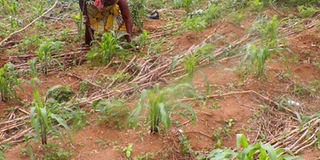Prime
Address land degradation in a timely manner

A farmer works on her young maize crop. COURTESY PHOTO
What you need to know:
- The issue: Degradation
- Our view: Areas at risk should be designated and put on a priority list for conservation and restoration. The time is now to slow down destruction of the environment by implementing laws and policies impartially and finding attractive alternatives to the practices that accelerate land degradation and cause climate-induced misery
In commemoration of World Environment Day, various bodies, both public and private, as well as individuals have come out to emphasise the damaging effects of human activity on our environment and particular ecosystems.
This year’s theme, aptly summarised as “Our land, our future” touches on a very important and sensitive resource which plays host to many human activities and natural habitats. Experts have redlined some areas in the country that are in danger of degradation and marked them as hotspots.
Some of those areas include Mt Elgon National Park and Mabira Forest, which have been documented as being in danger of decline owing to deforestation, among other destructive activities. Due to lost forest cover, plant and animal habitats are at risk as is the wildlife that inhabits those areas.
Areas in North Eastern Uganda are drought-prone as seen in recent times when sections of the population in Karamoja faced massive drought and resulting hunger.
The 2022 Human Rights and Freedoms report showed that at least 2000 deaths were registered in areas of Karamoja, owing to starvation and hunger-related illnesses. A food security and Nutrition Assessment put the number of children at risk of severe malnutrition, at more than 20,000 in 2022.
The effects of climate change continue to bite across the country in the form of flooding and landslides in Kasese, western Uganda and in the Eastern Uganda mountainous area of Bulambuli alongside other areas where floods razed homesteads and destroyed gardens, which were both sources of sustenance and livelihood. The affected areas require restoration after the storm has passed, in order to prevent future disasters.
However, while the causes and possible solutions to some of these climate-induced disasters have been well documented, it remains ever challenging to implement and prevent further degradation.
Communities are reluctant to let go of land in areas at risk, even when the signs of degradation are obvious and looming. The demand for land for agricultural production is also on the rise.
With slow movement on the part of environmental authorities to ensure timely restoration of degraded lands, it is a ticking time bomb in many spots across the country.
Areas at risk should be designated and put on a priority list for conservation and restoration. The time is now to slow down destruction of the environment by implementing laws and policies impartially and finding attractive alternatives to the practices that accelerate land degradation and cause climate-induced misery.




